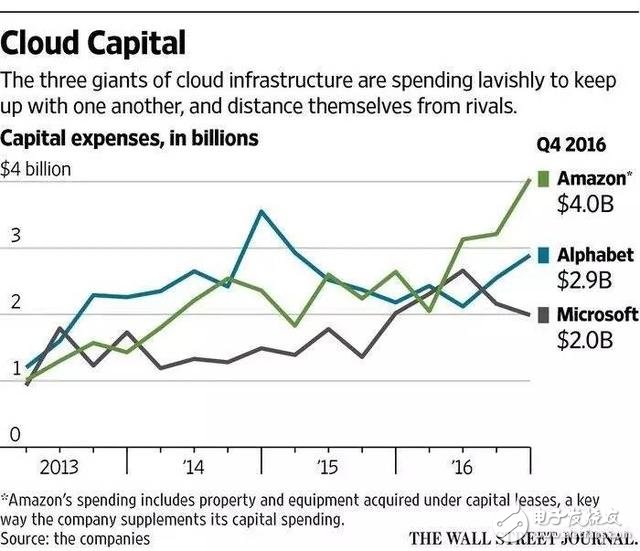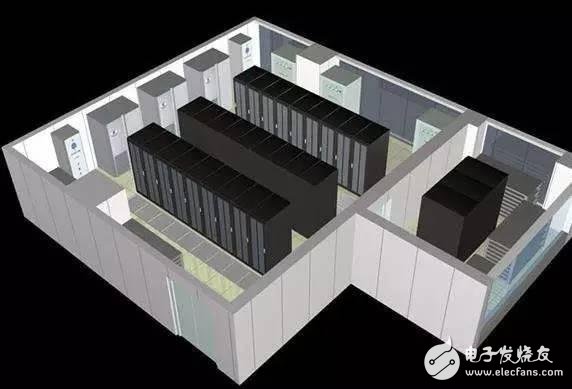Because of the cloud cake, Amazon, Microsoft, and Google have all tried their best to get rid of it. According to the data, Amazon, Microsoft and Alphabet (Google parent company) totaled $31.54 billion in capital expenditures and capital leases in 2016, a 22% increase from 2015. Each company lists cloud computing as a major investment area.
As the expansion of cloud computing is more and more radical, and almost into the "prisoner's dilemma." These three companies seem to have waged price wars, have reduced the price of some cloud products, and even caused concerns that prices may be too low due to continued price declines.

In this 1.0-mode universal cloud infrastructure service market led by Amazon, Microsoft and Google, is there no chance for latecomers? Not necessarily, the new gameplay of 2.0 mode cloud computing + edge computing is in the ascendant, cleverly becoming the turning point of cloud computing to avoid the "prisoner's dilemma."
Looking at the battle for the IoT platform, as the IoT is gradually affecting all aspects of production, manufacturing, and life, the IoT platform has become a strategic focus, and the number has soared in recent years. Whether it is Ali, Tencent, Baidu, Jingdong and other Internet giants; or Huawei, China Mobile, China Telecom, China Unicom and other operators, communications predators; or IBM, Microsoft, Cisco and other traditional IT companies; and Wisdom Cloud, Ablecloud, Qing New Internet of Things companies such as Branch and Bolian want to get a triangle in the big cake of IoT platform.
Although they are called IoT platform, the difference between connotation and substance is not small. If it can't be connected with the underlying equipment, the upper and the industrial application, and effectively empower the industry partners, the IoT platform can only be a false proposition.
Whether it is the cloud computing battle that needs to be upgraded, or the "red-eye" IoT platform campaign, the second half points to the same main position: edge computing.
Edge computing is not a reinventing conceptPeter Levine, a partner at Silicon Valley Ventures A16Z, once said that edge computing is the "terminator" of cloud computing. This statement is inevitably exaggerated for the eyeballs, but the reality of cloud computing and edge computing symbiosis has become the mainstream prejudgment of cloud computing and Internet of Things practitioners for the future.
From the technical definition, edge computing is an open platform that integrates network, computing, storage, and application core capabilities on the edge of the network near the source of data or data. It provides edge intelligent services to meet the industry's digitalization in agile connections and real-time services. Key requirements for data optimization, application intelligence, security and privacy protection.
Edge computing is not a new thing, nor is the IoT person boasting the concept of re-creation, but a counter-attack of the “long-standing†IoT distributed computing.
The characteristic of distributed computing is that each node has a computing function. The disadvantage is that each user needs to manage his own nodes, hardware, and software. So cloud computing appeared later, and a lot of data processing was given to the "cloud" to do it. This cloud computing is actually a centralized calculation, which solves the user's management troubles for central computing.
By the time of the "cloud", we have completed the transition from distributed computing to centralized computing. However, we now find that different IoT scenarios such as chicken feathers are not the best strategy by relying solely on centralized cloud computing. The “quick-calculation†capability of the edge is especially important for IoT applications.
So what is the best way to advance edge computing for industry applications?Some people try to do it themselves, explore new technologies, and hope to combine them into a viable solution. However, some people have found off-the-shelf, using edge computing solutions such as the Micro Modular Data Center (MDC).

MDC has been around for a while, and it is a set of hardware and software solutions for real-time acquisition, reporting and charting of detailed manufacturing data and processes in the shop floor. With the development of the Internet of Things, it is necessary to use a smaller MDC, that is, "micro-MDC", to quickly configure these modules to the edge scene to realize the deployment of computing power.
In the selection process of the micro MDC, the person who suggested came over to consider the following five points:Ensuring flexibility: Due to the ever-changing variety of application scenarios, micro-MDCs need to consider enough flexibility. Integrated solutions are not necessarily the best choice. It is often necessary to perform micro-MDC optimization steps for different environments.
Open foundation: On the IT side, there is a need to find scalable and manageable solutions to distribute more processing power to the edge. This poses a great challenge for the IT department. In order to achieve service agility, with an open and agile underlying infrastructure, it is extremely critical to automatically scale resource allocations as needed.
Empowerment analysis: It's one thing to deal with edge data, and analyzing edge data is another matter. Micro MDCs should have the ability to perform in-place analysis, the closer the high-speed devices or sensors that generate the data, the better, so that business insights can be quickly delivered.
Fast use: Not only does the micro MDC have flexible options for computing, storage, networking, power and cooling, but it should also be offered in a quasi-integrated solution that will ensure rapid installation and rapid value creation of the miniature MDC.
Unified management: Most of the solutions for edge computing are scattered, and it is not easy to achieve unified management. To do this, device providers need comprehensive integration and management capabilities to manage micro-MDCs, related data centers, IT equipment, and sensors from around the world from the same portal.
Dongguan Tuojun Electronic Technology Co., Ltd , https://www.fibercablessupplier.com